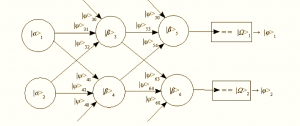 Getting back to metaphors in science, Wojciech Zurek’s so-called Quantum Darwinism is in the news due to a series of experimental tests. In Quantum Darwinism (QD), the collapse of the wave function (more properly the “extinction” of states) is a result of decoherence from environmental entanglement. There is a kind of replication in QD, where pointer states are multiplied, and then a kind of environmental selection as well. There is no variation per se, however, though some might argue that the pointer states imprinted by the environment are variants of the originals. Still, it makes the metaphor a bit thin at the edges, but it is close enough for the core idea to fit most of the floor-plan of Darwinism. Indeed, some champion it as part of a more general model for everything. Even selection among viable multiverse bubbles has a similar feel to it: some survive while others perish.
Getting back to metaphors in science, Wojciech Zurek’s so-called Quantum Darwinism is in the news due to a series of experimental tests. In Quantum Darwinism (QD), the collapse of the wave function (more properly the “extinction” of states) is a result of decoherence from environmental entanglement. There is a kind of replication in QD, where pointer states are multiplied, and then a kind of environmental selection as well. There is no variation per se, however, though some might argue that the pointer states imprinted by the environment are variants of the originals. Still, it makes the metaphor a bit thin at the edges, but it is close enough for the core idea to fit most of the floor-plan of Darwinism. Indeed, some champion it as part of a more general model for everything. Even selection among viable multiverse bubbles has a similar feel to it: some survive while others perish.
I’ve been simultaneously studying quantum computing and complexity theories that are getting impressively well developed. Richard Cleve’s An Introduction to Quantum Complexity Theory and John Watrous’s Quantum Computational Complexity are notable in their bridging from traditional computational complexity to this newer world of quantum computing using qubits, wave functions, and even decoherence gates.
Decoherence sucks for quantum computing in general, but there may be a way to make use of it. For instance, an artificial neural network (ANN) also has some interesting Darwinian-like properties to it. The initial weight distribution in an ANN is typically a random real value. This is designed to simulate the relative strength of neural connections. Real neural connections are much more complex than this, doing interesting cyclic behavior, saturating and suppressing based on neurotransmitter availability, and so forth, but assuming just a straightforward pattern of connectivity has allowed for significant progress.… Read the rest